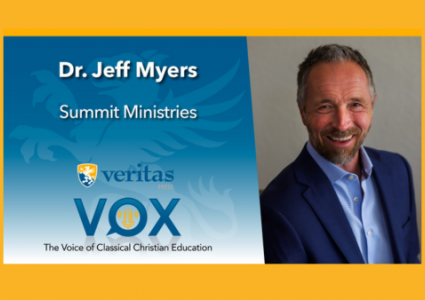The Veritas Approach to Grammar & Writing and Composition

No one disputes the need for children to learn to read and write. They’re two of the three R’s. But mastering grammar and writing exceptionally has fewer devotees. We’re guessing that’s because it’s hard to clearly define and even harder to produce in our students. Yet when we read something well written, it keeps our attention. We’re intrigued by cleverly turned phrases and metaphors that paint visual images we can’t forget—we can’t put down such writing.
At Veritas, the entire English curriculum is designed to teach your child to become one of those great writers. That’s not to say that everyone is equally gifted. Rather, our goal is to develop a child’s gifts fully.
The grammar of language is about language structure, how the words are constructed and the way they contribute to a sentence. Why do poorly written sentences and bad grammar even matter? The rules of language, grammar, word order—like any other rules—exist to systematize and prescribe what the speakers of that language agree to be correct and effective communication. Students who ignore or never learn what is considered proper English will be at a distinct disadvantage in their education and in life.
Historically, children have been taught Grammar for a long time. The first grammar text, written in 1586, was based on William Lily’s Latin grammar text. In the United States the first English grammar text was published in 1765. Up until the last generation, children were taught English grammar just like they were taught to read.
| Grade | Course Options |
|---|---|
1-2 | Grammar & Writing 1 or 2* |
3-6 | Grammar & Writing 3 – 6; or Grammar & Writing Transition (6th grade) |
6-7 | Composition I; or Grammar and Writing Transition |
8-9 | Composition I or II |
10-12 | Composition I or II English Electives (Live only) |
*You Teach only. All other courses have Live or You Teach options, except as noted.
Our search for the best grammar curriculum led us to Shurley English. We knew we wanted easy memorization, not logical deduction, to be the primary learning method. Through fun chanting, children in the grammar stage are taught the parts of speech and what makes a complete sentence. Imagine a six-year-old who can identify nouns, verbs, adjectives, adverbs, and prepositional phrases in sentences. Today we are amazed, but this was once the norm. Once children can identify parts of speech through a learned pattern, they are taught to write their own sentences. Then children are ready to learn how to write paragraphs and stories.
To teach writing classically, we wanted a program that modeled other writing as a key teaching technique. In the past, children were taught to write by modeling the masters. Over 20 years ago, we found the Institute for Excellence in Writing (IEW). This program follows patterns of composition similar to those taught in the classical exercises called the progymnasmata. Using this method, children learn by imitation, just like in ancient Greece and Rome. Now, more than 20 years later, we are even more convinced that this is the best way to learn to write.
With enough practice students will be ready to take the training wheels off. Students are now developing their own writing. The composition program we use was developed by us in partnership with the staff at WORLD Magazine.
WORLD is known for their excellent writing staff. So many times what children learn is theoretical in nature. We are pleased that through our composition curriculum your children can learn from and be inspired by those who actually write for a living. Students will learn many different styles of writing in Composition I and II. Further interest in writing can be further fostered through several electives offered as live online courses.
Finally, some students may need more work before starting a composition course. If your seventh grader has not had enough grammar and writing to go into Composition I, we offer a transition course that will allow the student to get caught up before moving on.







